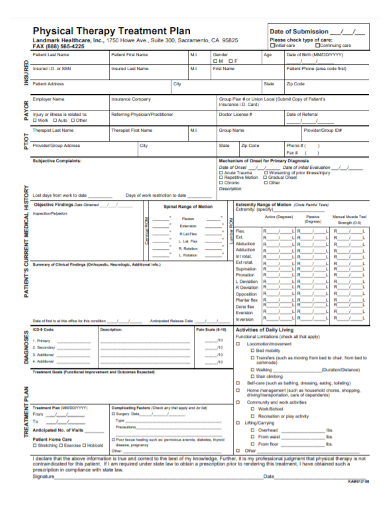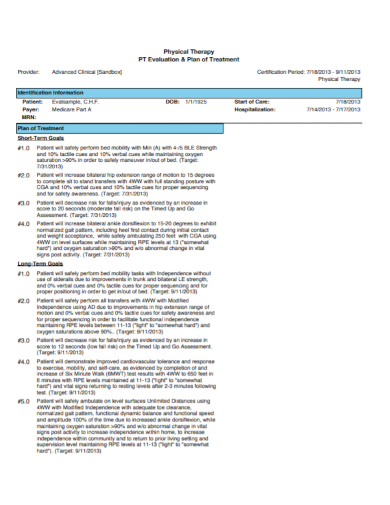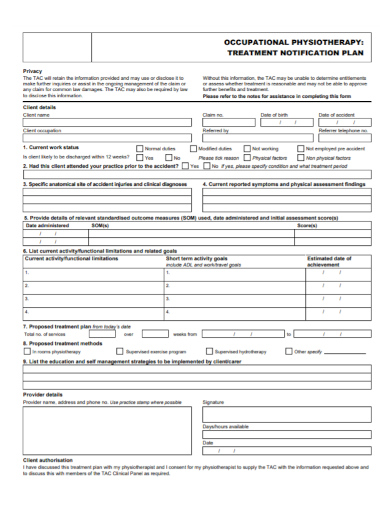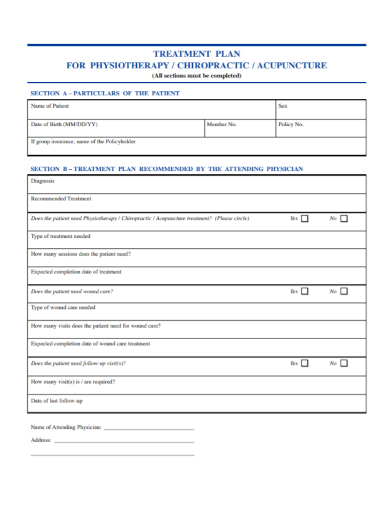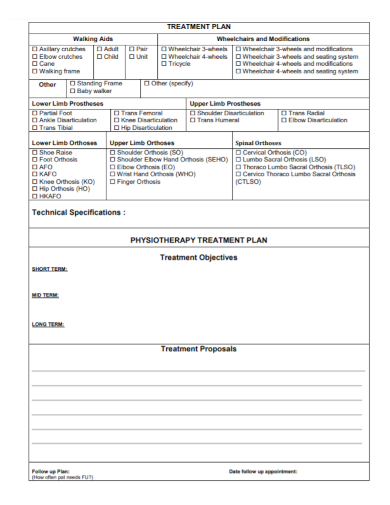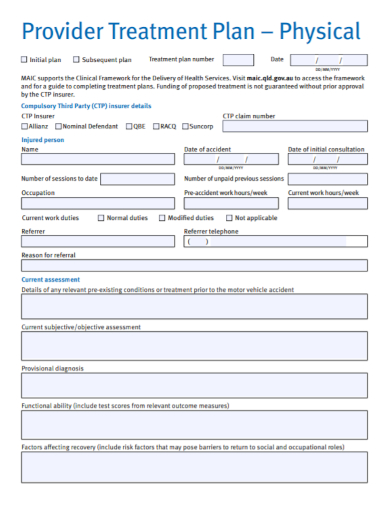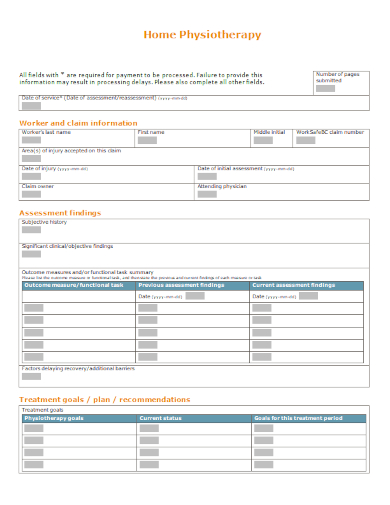Some people get into unfortunate accidents or have mobility problems that hinder them to do everyday things such as going to work, walk on their own, or doing leisure activities. For some, physiotherapy is needed to help them get their mobility back. Physiotherapy, just like any treatment, needs a plan to figure out what type of physiotherapy treatment is best for the patient. Read the article to know what details should be included in a physiotherapy treatment plan.
10+ Physiotherapy Treatment Plan Samples
1. Physiotherapy Treatment Plan
2. Physical Therapy Treatment Plan
3. Physical Therapy Evaluation Treatment Plan
4. Physiotherapy Treatment Notification Plan
5. Physiotherapy Treatment Management Plan
6. Occupational Physiotherapy Treatment Plan
7. Treatment Plan for Physiotherapy
8. Sample Physiotherapy Treatment Plan
9. Physiotherapy Provider Treatment Plan
10. Physiotherapy Clinic Survey Treatment Plan
11. Home Physiotherapy Treatment Plan
What is Physiotherapy Treatment?
Physiotherapy is the treatment of physical injury, deformity, or illness that is treated by physical methods rather than by medicinal drugs or surgery. Some usual physical problems that physiotherapy treatment apply to are:
- Sports injuries
- Back, neck, and shoulder pain
- Whiplash or strain injury
- Spinal and joint pain and dysfunction
- Bone fractures
- Postural pain
- Workplace or home injuries
Some methods of physiotherapy treatment for these problems are:
- Joint mobilization
- Electrotherapy
- Acupuncture
- Exercise and stretching
- Postural advice and core strengthening
- Muscle imbalance correction
- Sports specific rehabilitation
Details to Include in a Physiotherapy Treatment Plan
The Physiotherapy Treatment Management Plan is a document that is used as a communication between physiotherapists and their patients regarding their treatment. It demonstrates the identification and evaluation of the issues and their treatment. Physiotherapists are the ones assigned to create the treatment plan.
The details below are just some examples of what a physiotherapy treatment plan consists of. Every therapist or medical center has their treatment plans, and they might include some details that you won’t find below.
1. Patient details
Personal details about the patient should be included in this section. This section must also include the cause or reason of the patient’s physical issue, and any medical history, especially if the patient has been provided a previous management plan and the number of treatments the patient has received.
2. Evaluation
The evaluation process is an important part of the treatment plan since it studies and measures the treatment effectiveness for the client. This also helps inform the treatment team and the patient on the direction of the treatment and to enhance its outcome. The outcome measures for the evaluation used should be reliable, valid, and sensitive to change.
3. Planning
The planning part must focus on the goal for the patient to function their body to be able to return to work. The goals must follow the SMART format (it should be specific, measurable, appropriate, relevant, and time-bound). This section should explain the details of the treatment that is planned to be undertaken by the patient to achieve their goal.
4. Issues Identified
Once the treatment is taken by the client, the physiotherapist will monitor the progress of the patient. If the patient has not made the expected progress, the physiotherapist will identify why this is happening and will recommend actions to address these issues to overcome them all. The patient must be actively involved when identifying these issues. The physiotherapist and patient must discuss the factors that may point to a risk of non-recovery. The patient is encouraged to raise any concerns with their therapist that obstructing them to recover and return to their normal life.
4. Estimated Discharge Date
The discharge date must be estimated of when the patient will be ready for discharge. The estimated discharge date must be based on the current assessment and clinical reasoning of the physiotherapist. The estimated date can change anytime depending on circumstances.
FAQs
Which type of physiotherapy is common?
Orthopedic physiotherapy is the most common form of physiotherapy because it deals with a broad range of issues, especially in treating muscles and bones injuries.
What skills do you need for physiotherapy?
To be qualified to become a physiotherapist, one must possess good time management, good rapport between diverse patients, great communication skills, have long tolerance and patience, be great in working with teams, and must be physically fit.
What are the different types of physiotherapy?
- Neurological physiotherapy: This treatment aims at patients treating suffering from neuromuscular disorders to bring back their mobility and help function their neuromuscular system again.
- Orthopedic physiotherapy: This treatment focuses on repairing deformities and treating musculoskeletal system ailments.
- Cardiopulmonary physiotherapy: This treatment treats patients who suffer from cardiopulmonary disorders.
- Pediatric physiotherapy: This treatment gives therapeutic exercises to children to help them treat and improve acute injuries, birth defects, delayed physical growth, or other genetic defects that make them immobile.
- Geriatric physiotherapy: This treatment is catered to senior citizens to treat those age-related medical conditions by helping them with techniques and exercises to improve their mobility.
The treatment plan is created to plan different types of treatment for various individuals who are suffering from physiological disorders. The treatment plan should be discussed not only just between the patient and the physiotherapist, but also to the client’s family as well. To guide you on what a physiotherapy treatment plan consists of, download our free sample templates provided above!
Related Posts
FREE 10+ Quality Improvement Report Samples
FREE 10+ Physical Assessment Form Samples
FREE 10+ Patient Progress Note Samples
FREE 10+ Nursing Progress Note Samples
FREE 9+ Sample Physical Therapy Job Description
FREE 9+ Sample Physical Therapist Job Description
FREE 9+ Sample Massage Intake Forms
FREE 8+ Sample Parenting Plan
FREE 8+ Sample Risk Management Plan
FREE 7+ Sample Discharge Summary
FREE 45+ Medical Forms
FREE 10+ Investigation Plan Samples
FREE 10+ Sample Nursing Care Plan
FREE 8+ Nursing Note Templates
FREE 8+ Mental Health Counselor Job Description Samples


